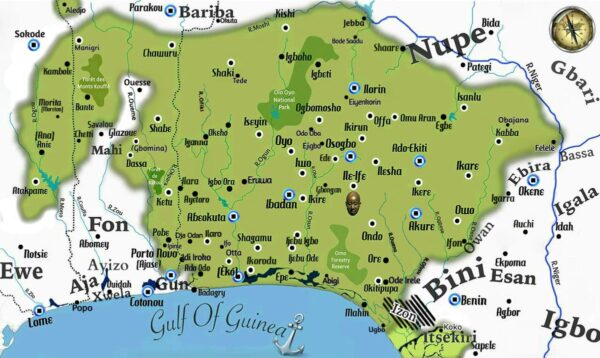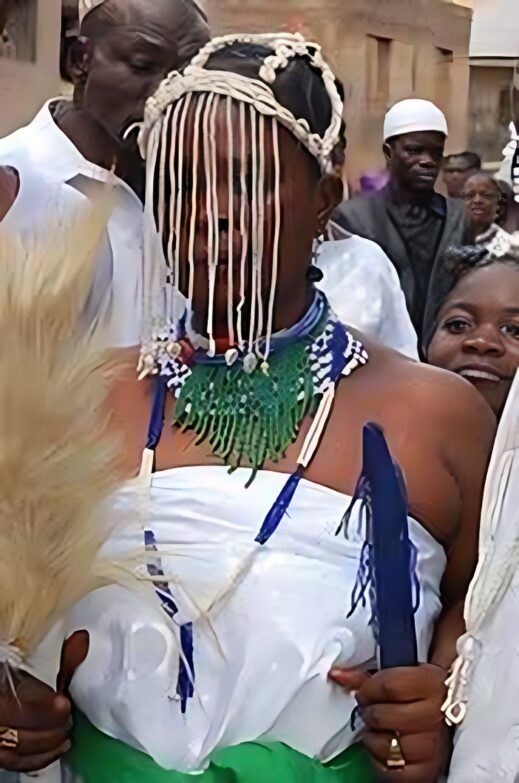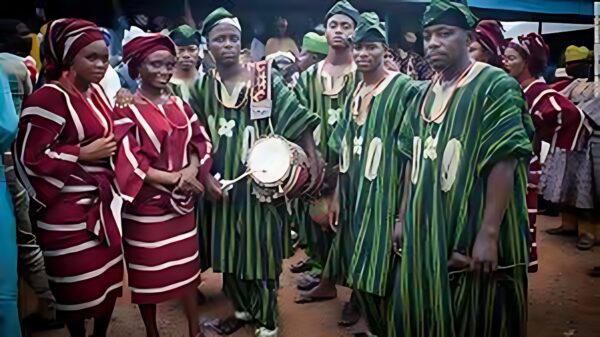Get ready to embark on a thrilling journey into the enchanting realm of the Yoruba culture! Brace yourselves, because we’re about to delve into the vibrant heritage of Nigeria and Africa’s most dynamic cultural phenomenon, one that has been making waves for centuries. Ladies and gentlemen, I present to you the captivating world of Yoruba culture, filled with a rich history that rivals even the fiercest jollof rice cook-off in terms of excitement and flavor!
The Yoruba culture is one of Nigeria and Africa’s most prominent and enthralling cultures, having a rich history spanning centuries. The Yoruba people, also known as; Omo Oduduwȧ or Ọmọ Káááró-oojíre are a West African ethnic group deeply rooted in southwestern Nigeria, as well as in parts of neighboring countries like Benin and Togo. Yoruba culture is characterized by a unique blend of mythology, religion, art, music, dance, and social institutions, with their primary language as Èdè Yoruba (Yoruba Language). Let’s explore the rich heritage and captivating history of Yoruba culture in Nigeria, from ancient traditions to modern influences.
- Mythology:
According to Yoruba mythology, Ile-Ife was where the Yoruba world was created by the supreme deity known as Olodumare (God). The Yoruba creation myth revolves around the figure of Oduduwa, who descended from heaven and is regarded as the progenitor of the Yoruba race and the first Ooni (king) of Ife, where he would go on and establish a dynasty that would give rise to several Yoruba kingdoms today. Oduduwa was blessed with a single child, “Okanbi” who then birthed seven children, namely Olowu of Owu, Onisbe of Sabe, Onipopo of Popo, Oba of Benin, Orangun of Ila, Alaketu of Ketu, and Alafin of Oyo.
- Origins and kingdoms:
After the death of Oduduwa, there was a dispersal of his descendants from Ife to found other kingdoms. Each child made its mark in the subsequent urbanization and consolidation of the Yoruba confederacy of kingdoms, with each kingdom tracing its origin to Ile-Ife.
The ancient city of Ile-Ife is the cradle of Yoruba civilization. Over time, from around the 12th century, numerous Yoruba city-states and kingdoms emerged, each with its own distinct ruler and cultural practices. Some of the notable Yoruba kingdoms included Oyo, Ife, Ijebu, Egba, Ketu, Ekiti, and Benin. These kingdoms were ruled by powerful kings known as “Obas” who held both political and religious authority.
The kingdoms thrived from the medieval period through the 19th century, engaging in trade, agriculture, and warfare. The most prominent of these was the Oyo Empire, which reached its zenith in the 17th and 18th centuries. The empire controlled vast territories and engaged in extensive trade, particularly in goods such as ivory, slaves, and palm oil.
- Art, Music, and Dance:
The Yoruba culture is renowned for its artistic traditions, particularly in the realm of sculpture, pottery, and beadwork. Yoruba artists produced exquisite bronze and terracotta sculptures, often depicting deities, ancestral figures, and kings. These artworks were not just decorative but held great religious and spiritual significance.
Hence, there’s Yoruba music which is characterized by complex rhythms, drumming, and the extensive use of percussion instruments. Yoruba music, including genres like Juju, Fuji, and Afrobeat, has gained international recognition through the works of musicians like King Sunny Ade, Fela Kuti, Ebenezer Obey, Wizkid, the Grammy award winners (Global Music Album of The Year Award), Angelique Kidjo (multiple), and Burna Boy. Bata Dance is the traditional Yoruba dance. Historically, the dance is believed to be attributed to “Sango” – the Yoruba god of Thunder and Lightning. The Bata dance is an expressive art not just imbued with rhythm and movements but avowed spirituality. The dancer connects with the drummer and pays close attention to the rhythm of the drum. The drums include: Bata, Gangan, Omele, lya Ilu, Sakara, Gudugudu, and Sekere.
- Religion:
Religion plays a crucial role in Yoruba culture. The Yoruba practice a traditional religion known as Ifa or Orisa worship. This religion is based on the veneration of deities known as Orishas. Ifá, a complex system of divination, involves a recital of Yoruba poetry containing stories and proverbs bearing on the divination. A divination recital can take a whole night. The body of this poetry is vast and passed on between Ifa oracles. The Orishas represent various forces of nature and human characteristics and are believed to have the power to influence human affairs.
The religion, therefore, has a strong belief in ancestor worship and the presence of spirits in the natural world. The pantheon of Orishas (deities) includes Ogun (god of iron), Sango (god of thunder), Osun (goddess of fertility), and Yemoja (goddess of the sea). Rituals, sacrifices, and divination ceremonies are performed to honour and communicate with these deities. These religious practices have spread beyond Nigeria and have gained followers in the Americas, particularly in countries such as Cuba, Brazil, and Trinidad and Tobago, where it is known as Santeria or Candomble.
- Language and Literature:
The Yoruba language, known as “Èdè Yorùbá,” is spoken by millions of people in Nigeria and the diaspora. It is a tonal language having a unique grammatical structure. Yoruba literature is rich in proverbs, poetry, and oral traditions. Yoruba writers have made significant contributions to African literature, with notable figures such as Bishop Samuel Ajayi Crowther, D.O. Fagunwa, Wole Soyinka, Amos Tutuola, and Afolabi Olabimtan. Although the use of Roman alphabets inspired the formation of the written Yoruba, it was indeed facilitated by the Yoruba people. The very first Yoruba grammar was published by Bishop Samuel Ajayi Crowther in 1843, who proceeded to translate the Holy Bible to Yoruba and published it in 1884. The first history of Yoruba was compiled in 1897 by Reverend Samuel Johnson, who is also of Yoruba origin.
- Cultural Practices:
Yoruba culture is characterized by vibrant festivals, colourful attire, and traditional ceremonies. Amongst these traditional clothing are Adire, Kampala, Ofi or Aso Oke, the agbada (a flowing gown), buba (blouse), iron (wrapper), and gele (head tie) for women, while men often wear the buba and sokoto (trousers) with a cap or fila. The Yoruba people celebrate various festivals throughout the year, the most prominent being the Egungun Festival.
Egungun, “cult of the ancestor,” sees the traditional rite controlled by men who are descendants of a particular ancestral figure and culminates in a masquerade to depict the ancestors returning to the world of the living to visit their descendants. Other notable festivals are the Eyo Festival, the annual Olojo Festival in Ile-Ife and the Osun-Osogbo Festival in Osun State, each attracting visitors from around the world.
- Transatlantic Slave Trade and Diaspora:
During the 18th and 19th centuries, the Yoruba people experienced the devastating impact of the transatlantic slave trade. Many Yoruba individuals were captured and forcibly transported as slaves to the Americas, particularly to countries like Brazil, Cuba, and Trinidad and Tobago. As a result, Yoruba cultural elements, such as religion, language, music, and dance, were carried across the Atlantic and influenced the development of Afro- Caribbean and Afro-Latin cultures. All these would lead to the significant spread of the culture today across the countries, especially in Brazil, where the Nagos people established widely.
- Post-Colonial Era and Modern Yoruba Culture:
Nigeria, including Yorubaland, came under British colonial rule in the late 19th century. Despite colonial influence, the Yoruba people have managed to preserve and maintain their cultural heritage. After Nigeria gained independence in 1960, Yoruba traditions experienced a resurgence and a renewed sense of cultural pride. Although many Yoruba embraced Christianity or Islam, aspects of their traditional religion survive. Today, Yoruba culture continues to thrive in Nigeria and the diaspora. Yoruba festivals, such as the annual Olojo Festival in Ile-Ife and the Osun- Osogbo Festival in Osun State, attract a wide range of visitors from around the world.
- Exclusively:
There’s a small Yoruba town called Igbo-Ora, a serene town in Oyo state with a simple way of life, occupied mostly by farmers and traders. This town is considered the Twin capital of the world. This is because more twins are born in Igbo-Ora than anywhere else in the world. To boast about 158 sets of twins for every 1000 childbirth is such a large feat that it leaves almost every house with at least one set of twins. When the community leaders were interviewed on the secrets of this amazing occurrence, it was linked to the consumption of tuber foods and a particular Ilasa soup (okra leaf).
Research, however, shows the theory to be believable, as a high level of a chemical found in the peelings of a particular cassava and yam tubers was also found in the women. According to a 2001 BBC interview, a consultant gynecologist who had seen many of the multiple births at the hospital says: “These substances are usually linked to the release of more than one egg, which usually leads to twin pregnancies.“
Ultimately, the Yoruba culture in southwestern Nigeria is an enchanting fuse of history, mythology, art, religion, culture and tradition. It continues to shape the identity of the Yoruba people and serves as a source of pride and inspiration for future generations.
However, in more recent decades, Lagos has risen to be the most illustrious city of the Yoruba people and Yoruba cultural and economic influence. Noteworthy among the developments are uniquely styled architectures introduced by returning Yoruba communities from Britain, America, Brazil and Cuba.










